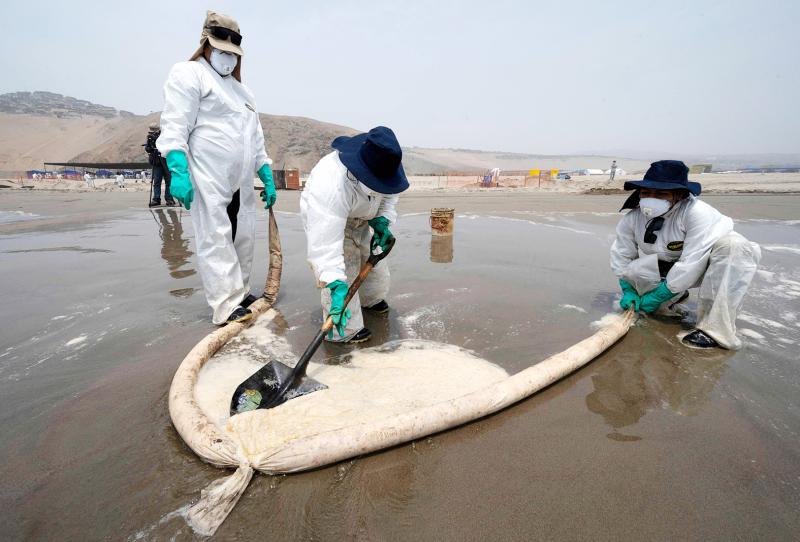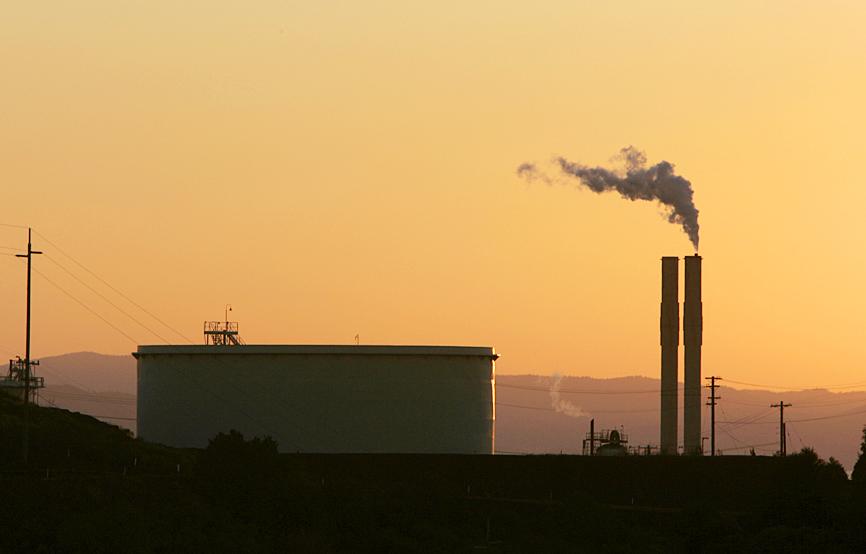Accusations of greenwashing against major oil companies that claim to be in transition to clean energy are well-founded, according to the most comprehensive study to date.
The research, published in a peer-reviewed scientific journal, examined the records of ExxonMobil, Chevron, Shell and BP, which together are responsible for more than 10 percent of global carbon emissions since 1965. The researchers analysed data over the 12 years up to 2020 and concluded the company claims do not align with their actions, which include increasing rather than decreasing exploration.
The study found a sharp rise in mentions of “climate”, “low-carbon” and “transition” in annual reports in recent years, especially for Shell and BP, and increasing pledges of action in strategies. But concrete actions were rare and the researchers said: “Financial analysis reveals a continuing business model dependence on fossil fuels along with insignificant and opaque spending on clean energy.”

Photo: AFP
Numerous previous studies have shown there are already more reserves of oil and gas and more planned production than could be burned while keeping below the internationally agreed temperature target of 1.5C. In May last year, the International Energy Agency (IEA) said there can be no new fossil fuel developments if the world is to reach net zero by 2050.
Oil companies are under increasing pressure from investors to align their businesses with climate targets. But their plans have faced scepticism, prompting the researchers to conduct the new research, which they said was objective and comprehensive.
“Until there is very concrete progress, we have every reason to be very sceptical about claims to be moving in a green direction,” said Gregory Trencher, at Kyoto University in Japan, who worked with Mei Li and Jusen Asuka at Tohoku University.

Photo: AP
“If they were moving away from fossil fuels we would expect to see, for example, declines in exploration activity, fossil fuel production, and sales and profit from fossil fuels,” he said. “But if anything, we find evidence of the reverse happening.”
“Recent pledges look very nice and they’re getting a lot of people excited, but we have to put these in the context of company history of actions,” Trencher said. “It’s like a very naughty schoolboy telling the teacher ‘I promise to do all my homework next week’, but the student has never worked hard.”
The new study, published in the journal PLOS One, found mentions of climate-related keywords in annual reports rose sharply from 2009 to 2020. For example, BP’s use of “climate change” went from 22 to 326 mentions.
But in terms of strategy and actions, the researchers found “the companies are pledging a transition to clean energy and setting targets more than they are making concrete actions.”
Chevron and ExxonMobil were “laggards” compared to Shell and BP, the researchers said, but even the European majors’ actions appeared to contradict their pledges. For example, BP and Shell pledged to reduce investments in fossil fuel extraction projects, but both increased their acreage for new exploration in recent years, the researchers said.
Furthermore, the analysis found Shell, BP, and Chevron increased fossil fuel production volumes over the study period. None of the companies directly releases data on their investments in clean energy, but information they provided to the Carbon Disclosure Project indicates low average levels ranging from 0.2 percent by ExxonMobil to 2.3 percent by BP of annual capital expenditure (capex). Separate analysis by the IEA indicates that investment in clean energy by oil and gas companies was about 1 percent of capex in 2020.
“Until actions and investment behavior are brought into alignment with discourse, accusations of greenwashing appear well-founded,” the researchers said.
A spokesperson for ExxonMobil said: “The move to a lower emission future requires multiple solutions that can be implemented at scale. We plan to play a leading role in the energy transition, while retaining investment flexibility across a portfolio of evolving opportunities, including for example carbon capture, hydrogen and biofuels, to maximize shareholder returns.”
A Chevron spokesperson said: “We are focused on lowering the carbon intensity in our operations and seeking to grow lower carbon businesses along with our traditional business lines. We are planning US$10 billion in lower carbon investments by 2028.”
Shell’s spokesperson said: “Shell’s target is to become a net zero emissions energy business by 2050, in step with society. Our short, medium and long term intensity and absolute targets are consistent with the more ambitious 1.5C goal of the Paris Agreement. We were also the first energy company to submit its energy transition strategy to shareholders for a vote, securing strong endorsement.”
A spokesperson for BP said: “In 2020 BP set out our new net zero ambition, aims and strategy, and in 2021 completed the largest transformation of the company in our history to deliver these. Because this paper looks back historically over the period 2009-2020, we don’t believe it will take these developments and our progress fully into account.”
Trencher rejected the charge that the analysis was out of date: “We included the documents that were published during 2021, so the so-called data gap is only about six months and we don’t find any evidence of any new actions that would change any of our findings.”
“Unfortunately, the way the energy markets are structured around the world, fossil fuels still enjoy many [regulatory and tax] advantages and renewables are still disadvantaged,” he said.

That US assistance was a model for Taiwan’s spectacular development success was early recognized by policymakers and analysts. In a report to the US Congress for the fiscal year 1962, former President John F. Kennedy noted Taiwan’s “rapid economic growth,” was “producing a substantial net gain in living.” Kennedy had a stake in Taiwan’s achievements and the US’ official development assistance (ODA) in general: In September 1961, his entreaty to make the 1960s a “decade of development,” and an accompanying proposal for dedicated legislation to this end, had been formalized by congressional passage of the Foreign Assistance Act. Two

March 31 to April 6 On May 13, 1950, National Taiwan University Hospital otolaryngologist Su You-peng (蘇友鵬) was summoned to the director’s office. He thought someone had complained about him practicing the violin at night, but when he entered the room, he knew something was terribly wrong. He saw several burly men who appeared to be government secret agents, and three other resident doctors: internist Hsu Chiang (許強), dermatologist Hu Pao-chen (胡寶珍) and ophthalmologist Hu Hsin-lin (胡鑫麟). They were handcuffed, herded onto two jeeps and taken to the Secrecy Bureau (保密局) for questioning. Su was still in his doctor’s robes at

Last week the Democratic Progressive Party (DPP) said that the budget cuts voted for by the China-aligned parties in the legislature, are intended to force the DPP to hike electricity rates. The public would then blame it for the rate hike. It’s fairly clear that the first part of that is correct. Slashing the budget of state-run Taiwan Power Co (Taipower, 台電) is a move intended to cause discontent with the DPP when electricity rates go up. Taipower’s debt, NT$422.9 billion (US$12.78 billion), is one of the numerous permanent crises created by the nation’s construction-industrial state and the developmentalist mentality it

Experts say that the devastating earthquake in Myanmar on Friday was likely the strongest to hit the country in decades, with disaster modeling suggesting thousands could be dead. Automatic assessments from the US Geological Survey (USGS) said the shallow 7.7-magnitude quake northwest of the central Myanmar city of Sagaing triggered a red alert for shaking-related fatalities and economic losses. “High casualties and extensive damage are probable and the disaster is likely widespread,” it said, locating the epicentre near the central Myanmar city of Mandalay, home to more than a million people. Myanmar’s ruling junta said on Saturday morning that the number killed had